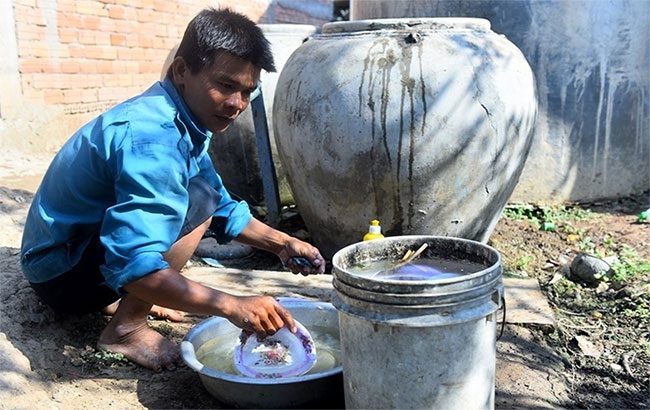These measures apply to households that have not been supplied with clean water from centralized water supply facilities or in emergency situations where clean water is unavailable.
The Ministry of Health recommends that people should choose water from dug wells or drilled wells for treatment. In cases where there are no groundwater sources, surface water from ponds, lakes, rivers, and canals should be used. It is important to select locations that are least likely to be contaminated, and to try to collect water as far away from the shore as possible.
The first step in treating water is to clarify it. Currently, two popular and simple methods for clarifying water are using alum and filtering with clean cloth.

People in drought and flood-affected areas lacking clean water can apply simple water treatment methods to obtain water for daily use. (Photo: Le Quan).
For the method using alum, people should follow the ratio of one gram of alum to 20 liters of water. If alum is not available, families can use clean cloth to filter the water several times until it becomes clear. For this method, it is important to use cotton filtering fabric and replace it when it is heavily soiled.
If the surface water source is too turbid or contains a lot of silt, families should filter out excess silt with a layer of gauze before clarifying the water.
After clarifying the water, people can disinfect it using chemicals or by boiling.
Households can disinfect water using Chloramine B. The most commonly available type is the 0.25-gram Chloramine B tablet or the 67 mg Aquatabs, which are very convenient for disinfecting small volumes of water like jars, pots, buckets, basins, or small tanks.
One 0.25-gram Chloramine B tablet can disinfect 25 liters of clear water, while one 67 mg Aquatabs can disinfect 20 liters of clear water.
For water supplied to communities or multiple households, people can disinfect it using powdered chemicals (usually 27% active chlorine Chloramine B or calcium hypochlorite).
However, the Ministry of Health advises that this disinfection process must be directed and guided by health officials. In addition, people should not disinfect simultaneously with adding alum as alum reduces the disinfecting effect of chlorine.
Disinfection is effective only when a chlorine smell is detected. If too much chlorine is added, people need to open the lid and wait another half hour to an hour for the smell to dissipate before using.
Before proceeding with disinfection, users should check the expiration date of the chemicals. It is advisable to use chemicals that are still within their expiration date to ensure the proper dosage and effectiveness of disinfection.
After completing the two steps of clarifying and disinfecting, the water can be used for household purposes. However, this water must still be boiled before drinking directly. Water that has been boiled should not be left for too long, so it is advisable to boil fresh water daily for drinking.
In cases where disinfecting chemicals are unavailable, people should only consume thoroughly boiled water and avoid eating raw vegetables washed with un-disinfected water.
In addition to the above water treatment methods, households can also use filtration devices for water treatment. The effectiveness of the filtration device depends on the quality of the input water, filtering technology, condition and quality of the filter device, and length of use, etc.
Currently, the market offers many types of water filtration devices from various brands with different technologies. People should use devices that have been tested by relevant authorities and follow the manufacturer’s instructions to ensure effective water filtration.
If using a water filtration device, people should ensure they use pre-clarified water and not directly use surface water from ponds, lakes, rivers, or canals to avoid clogging the filter device.


















































